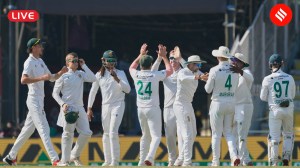Arranged marriages still work, they are still honourable
The confusion in world cricket at the moment reminds me a bit of what happens immediately...

The confusion in world cricket at the moment reminds me a bit of what happens immediately after the light turns green at a busy Mumbai traffic junction. Everybody is in a hurry to get ahead but some people haven’t yet finished turning right from the earlier signal. People are veering left, getting exasperated at the auto rickshaw and the ability of the driver to ignore curses hurled at him; a bus is blocking the next lane, everyone is honking, there is a lot of noise, the people ten cars behind are getting worked up fearing they may miss another signal¿And yet it happens all the time. Four hundred yards later, equilibrium is reached, the chaos has sorted itself out, another path has been found and everybody moves on till the next traffic junction. You know what is going to happen and yet, you can’t stop yourself getting annoyed, thinking you own the traffic and that, therefore, it must follow your needs.
If you don’t understand Mumbai’s traffic you can’t drive in it. If you are worked up and angry, you soon discover that the guy in the car next to you couldn’t care less. And now, the cricket world is discovering that if they want a share of the riches that corporate India bestows onto Indian cricket, they need to learn to drive in India. At the moment they are getting exasperated, frustrated and angry, they are used to driving in their own lane, used to the predictability of giving way at a roundabout and can’t fathom what to do with the spontaneity of Indian cricket.
They, Australia in particular, don’t know what it is to dart into the next lane, ignore the look, and dart back. Australia have been leaders in world cricket and suddenly there is an unknown monster, the IPL, upon them. Australia have been leaders, at thought and at organisation, and that combination has meant they have been leaders on the playing field as well. On both those counts, thought and organisation, India have been closer to the bottom and it is only the ability to live in Brownian motion, in constant chaos (and the use of the word ‘chaos’ is not derogatory but descriptive) that has allowed India to have its occasional moment in the sun. Now Australia fear they are going to get a touch marginalised and so they are digging in, making sporadic attacks; some justified, some, like Tim May’s suggestion that the IPL compensate cricket boards, laughable.
In course of time, the equivalent of the four hundred yards after a Mumbai traffic signal, there will be order again and people will know where they stand. But while that happens, people will do what they think right. However, they will have to co-exist, like the BMW does with the auto-rickshaw, and to be able to do that they must understand each other, appreciate that they need each other, that everybody has a right to be on the road, and that therefore, one is not necessarily more correct than the other.
The lesson from this year’s tour of Australia is that world cricket needs India and Australia to understand each other and their cultures better. Hawkish, sensationalist, stances don’t help. India has the money, Australia play cricket better and harder than the others, the two need each other. Arranged marriages still work, they are still honourable.
And while on the topic of confusion, there is yet another that will soon confront the IPL, or more specifically the franchise owners. For years now, to the young man in Karol Bagh or Triplicane, Sachin Tendulkar scoring runs is something to revel about. Can they, in their minds, reconcile to the idea that a Tendulkar dismissal is a moment of celebration? That if Lee playing for Chennai gets Tendulkar playing for Mumbai out, they are supposed to cheer for Lee? Can they pray to their gods the previous evening that Tendulkar or Ganguly or Dravid gets out early? Can the kid in Bandra or Himayatnagar hope that Nel gets Dhoni or that Gilchrist smashes Sreesanth? And then, a month later, wish for the opposite?
After having spent years adoring cricketers who play for India, can they feel similarly about their city? I know it happens in football all the time but you don’t have the dramatic one-on-one contests in football that you do in cricket. It will take time to get used to the idea of supporting two teams for cricket has aroused nationalistic feelings like few other things have. Much has to happen still, those four hundred yards are going to take time to negotiate. But there will be equilibrium in the end.



- 01
- 02
- 03
- 04
- 05



























